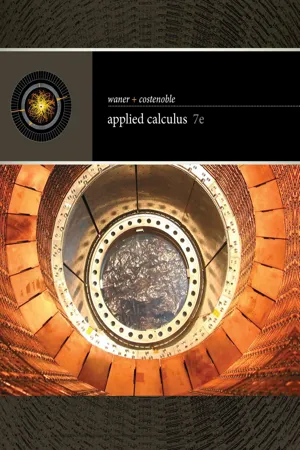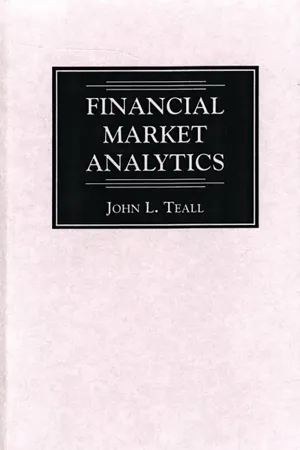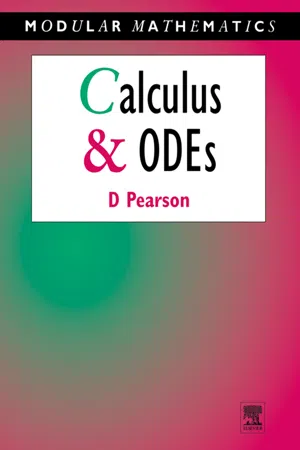Mathematics
Indefinite Integral
An indefinite integral is a fundamental concept in calculus that represents the family of antiderivatives of a given function. It is denoted by the symbol ∫ and is used to find the general form of a function whose derivative is known. The result of an indefinite integral is expressed as a function plus an arbitrary constant.
Written by Perlego with AI-assistance
Related key terms
1 of 5
10 Key excerpts on "Indefinite Integral"
- eBook - PDF
- Stefan Waner, Steven Costenoble(Authors)
- 2017(Publication Date)
- Cengage Learning EMEA(Publisher)
Integral calculus is concerned with problems that are in some sense the reverse of the problems seen in differential calculus. For example, where differential calculus shows how to compute the rate of change of a quantity, integral calculus shows how to find the quantity if we know its rate of change. This idea is made precise in the Fundamental Theorem of Calculus . Integral calculus and the Fundamental Theorem of Calculus allow us to solve many problems in economics, physics, and geometry, including one of the oldest problems in mathematics: computing areas of regions with curved boundaries. 13.1 The Indefinite Integral Antiderivatives and the Indefinite Integral Suppose that we knew the marginal cost to manufacture an item and we wanted to reconstruct the cost function. We would have to reverse the process of differentiation to go from the derivative (the marginal cost function) back to the original function (the total cost). We’ll first discuss how to do that and then look at some applications. Here is an example: If the derivative of F 1 x 2 is 4 x 3 , what was F 1 x 2 ? We recognize 4 x 3 as the derivative of x 4 . So we might have F 1 x 2 5 x 4 . However, F 1 x 2 5 x 4 1 7 works just as well. In fact, F 1 x 2 5 x 4 1 C works for any number C . Thus, there are infinitely many possible answers to this question. In fact, we will see shortly that the formula F 1 x 2 5 x 4 1 C covers all possible answers to the question. Let’s give a name to what we are doing. Antiderivative An antiderivative of a function f is a function F such that F r 5 f . Quick Examples 1. An antiderivative of 4 x 3 is x 4 . Because the derivative of x 4 is 4 x 3 2. Another antiderivative of 4 x 3 is x 4 1 7 . Because the derivative of x 4 1 7 is 4 x 3 3. An antiderivative of 2 x is x 2 1 12 . Because the derivative of x 2 1 12 is 2 x Thus, If the derivative of A 1 x 2 is B 1 x 2 , then an antiderivative of B 1 x 2 is A 1 x 2 . - eBook - PDF
- Stefan Waner, Steven Costenoble(Authors)
- 2017(Publication Date)
- Cengage Learning EMEA(Publisher)
Integral calculus is concerned with problems that are in some sense the reverse of the problems seen in differential calculus. For example, where differential calculus shows how to compute the rate of change of a quantity, integral calculus shows how to find the quantity if we know its rate of change. This idea is made precise in the Fundamental Theorem of Calculus. Integral calculus and the Fundamental Theorem of Calculus allow us to solve many problems in economics, physics, and geometry, including one of the oldest problems in mathematics: computing areas of regions with curved boundaries. 6.1 The Indefinite Integral Antiderivatives and the Indefinite Integral Suppose that we knew the marginal cost to manufacture an item and we wanted to reconstruct the cost function. We would have to reverse the process of differentiation to go from the derivative (the marginal cost function) back to the original function (the total cost). We’ll first discuss how to do that and then look at some applications. Here is an example: If the derivative of F 1 x 2 is 4x 3 , what was F 1 x 2 ? We recognize 4x 3 as the derivative of x 4 . So we might have F 1 x 2 5 x 4 . However, F 1 x 2 5 x 4 1 7 works just as well. In fact, F 1 x 2 5 x 4 1 C works for any number C. Thus, there are infinitely many possible answers to this question. In fact, we will see shortly that the formula F 1 x 2 5 x 4 1 C covers all possible answers to the question. Let’s give a name to what we are doing. Antiderivative An antiderivative of a function f is a function F such that F r 5 f . Quick Examples 1. An antiderivative of 4x 3 is x 4 . Because the derivative of x 4 is 4x 3 2. Another antiderivative of 4x 3 is x 4 1 7. Because the derivative of x 4 1 7 is 4x 3 3. An antiderivative of 2x is x 2 1 12. Because the derivative of x 2 1 12 is 2x Thus, If the derivative of A 1 x 2 is B 1 x 2 , then an antiderivative of B 1 x 2 is A 1 x 2 . - eBook - PDF
Quick Calculus
A Self-Teaching Guide
- Daniel Kleppner, Peter Dourmashkin, Norman Ramsey(Authors)
- 2022(Publication Date)
- Jossey-Bass(Publisher)
CHAPTER THREE Integral Calculus In this chapter you will learn about: • Antiderivatives and the Indefinite Integral; • Integrating a variety of functions; • Some applications of integral calculus; • Finding the area under a curve; • Definite integrals with applications; • Multiple integrals. The previous chapter was devoted to the first major branch of calculus—differential calculus. This chapter is devoted to the second major branch—integral calculus. The two branches have different natures: differential calculus has procedures that make it possible to differentiate any continuous function; integral calculus has no such general procedures—every problem presents a fresh puzzle. Nevertheless, integral calculus is essential to all of the sci- ences, engineering, economics, and in fact to every discipline that deals with quantitative information. There are two routes to introducing the concepts of integration. Although they start in different directions, they finally meld and create a single entity. If they were marked by road signs, the first would be “Antiderivatives and the Indefinite Integral” while the second would be “Area under a curve and the definite integral.” 169 170 Integral Calculus Chap. 3 3.1 Antiderivative, Integration, and the Indefinite Integral 306 The Antiderivative: The goal of this section is to learn some techniques for integration, sometimes called anti- differentiation. In this section we generally designate a function by f (x). The concept of the antiderivative is fundamental to the process of integration and is easily explained. When a function F (x) is differentiated to give f (x) = dF∕dx, then F (x) is an antiderivative of f (x), that is, F ′ (x) = f (x). This notation describes the defining property of the antiderivative, although only in terms of the derivative F ′ (x), not F (x) itself. The antiderivative is usually written in the form: F (x) = ∫ f (x)dx. The expression ∫ f (x) dx is also called the integral of f (x). - eBook - PDF
- John L. Teall(Author)
- 1999(Publication Date)
- Praeger(Publisher)
6 Integral Calculus 6.A: ANTIDIFFERENTIATION AND THE Indefinite Integral (Background Reading: Section 5.C) The two most important concepts in calculus are the derivative and the integral. A geometric interpretation of the derivative is the slope of a curve given by function f(x); the analogous geometric interpretation of the integral is the area under a curve represented by the function f(x). Integrals are most useful for finding areas under curves, and for finding expected values and variances based on continuous distributions. As the D operator is used for summing countable numbers of objects, integrals are used for performing summations of uncountably infinite objects. One may find the integral of a function using the process of antidifferentiation which is the inverse process of differentiation. If F(x) is a function of x whose derivative equals f(x), then F(x) is said to be the antiderivative or integral of f(x), written as follows: (6.1) The integral sign J is used to denote the antiderivative of the integrand f(x); the Indefinite Integral is denoted by j f(x)dx. We infer the following from Equation (6.1): (6.2) Consider the following function: f(x) = 3x 2 . This function is the derivative of what function? That is, what is the antiderivative of f(x)? F(x) = x 3 + k is the antiderivative of f(x) where k is simply a real valued constant since: Thus, the derivative of the function F(x) is our original function f(x); F(x) is the antiderivative of f(x). The constant of integration k must be included in the antiderivative. Thus, all of the following could be antiderivatives of 3x 2 : F(x) = x 3 + 2, F(x) = x 3 + 600 and F(x) = x 3 + 3.5. It is important for the antiderivative computation to be able to accommodate any of these possible constant values k. The following are a few of the rules which apply to the computation of Indefinite Integrals (where k is a real valued constant): (6.3) (6.4) (6.6) (6.7) Other rules are provided in Appendix 6.A. - eBook - PDF
- David Pearson(Author)
- 1995(Publication Date)
- Butterworth-Heinemann(Publisher)
An antiderivative is a function, an Indefinite Integral is a set of functions; but a definite integral is a number. How is this number defined? Given a functionf(x) on a finite interval a ~ x :::; b, the definite integral of f across the interval, written J:f(x)dx, may be thought of as the area between the graph y == f(x) and the x-axis, for values of x in the given interval. Areas above the x-axis, wheref(x) > 0, count as positive, and areas below the x-axis count as negative. If t is the input variable, then the same definite integral will be denoted by J: f(t)dt. Thus J:f(t)dt == J:f(x)dx. In Fig 9.1, J:f(x)dx is the shaded area indicated, whereas in Fig 9.2 J:f(x)dx is the shaded area above the x-axis, marked with a plus, minus the shaded area below the x-axis, marked with a minus. It will be anticipated from the notation that J: f(x)dx has something to do with antiderivatives and the Indefinite Integral, though it may not be so obvious ab initio how these different types of integral are related. In this chapter, I shall set out the properties of the definite integral and show how it is to be determined. We shall see too that the definite integral is not only an area, but also has many other interpretations. y o a b Fig 9.1 A definite integral. y [Y= ,(x) I Fig 9.2 A definite integral with signs. 132 Calculus and ODEs 9.1 The definite and Indefinite Integral Although the integral as area gives an intuitive idea of the definite integral, this by no means amounts to a formal definition, and many questions remain to be answered. We are all familiar with areas of simple geometrical figures, but precisely what is meant by the area between a general curve and the x-axis? We know that there are functions which do not have a derivative. Presumably too there may be functions for which J:J(x)dxjust does not make sense. - eBook - PDF
A Course of Higher Mathematics
Adiwes International Series in Mathematics, Volume 1
- V. I. Smirnov, A. J. Lohwater(Authors)
- 2014(Publication Date)
- Pergamon(Publisher)
CHAPTER III INTEGRATION: THEORY AND APPLICATIONS § 8. Basic problems of the integral calculus· The Indefinite Integral 86. The concept of an Indefinite Integral. One of the basic tasks of the differential calculus is to find the derivative or differential of a given function. The primary task of the integral calculus consists in the converse — finding the function, given its derivative or differential. Let the derivative or differential ày = f(x) àx be given of the unknown function y. A function F(x), possessing a given function f(x) as its derivative, or f{x)dx as its differential, is called a primitive of the given function f(x). If, for example, f(x) = x a primitive of the function will be F(x) = — # 3 ; we have, in fact, ^-L x 3J / = _ L x 3 x 2 = : X 2 Suppose that a primitive F(x) of the given function f(x) has been found, so that we have the relationship F'(z)=f(z). Since the derivative of an arbitrary constant C is equal to zero, we also have: [F(x)+C]' = F'{x)=f(x), i.e. the function F(x) + C is also a primitive of f(x). Hence it follows that, if the problem of finding a primitive has one solution, it will have an infinity of further solutions, differing 213 214 INTEGRATION: THEORY AND APPLICATIONS [86 from the first by an arbitrary constant. On the other hand, it can be shown that there are no other solutions apart from these, i.e. If F(x) is any one primitive of a given function f(x), any other primi-tive has the form : F{x) + G , where G is an arbitrary constant. Let F x (x) be any function, whose derivative is f(x) . We have : Fi(x)=f(x). On the other hand, F(x) possesses the derivative f(x), i.e. F'{x)=f{z). Subtracting this equation from the previous one, we get: F[(x) - F'(x) = [F^x) - F(x)Y = 0 , whence, by the theorem proved in [63]: F,(x) - F(x) = C , where G is a constant: which it was required to prove. - eBook - PDF
- G. M. Fikhtengol'ts, I. N. Sneddon(Authors)
- 2014(Publication Date)
- Pergamon(Publisher)
Example. Suppose that/(;c) = x 2 ; then it is readily observed that the Indefinite Integral of this function is JVi/x = — +C. This can easily be verified by the inverse operation of differentiation. t In this case it is also said that function F(x) is the primitive (or the integral) for the differential expression f(x) dx. § 1. Indefinite Integral 301 We draw the reader's attention to the fact that under the integral sign J we write the differential of the unknown primitive function, not the derivative (in our example x 2 dx, not x 2 ). This form of notation is historical; it will be explained later [Sec. 175]. Moreover, it has many advantages and therefore its preservation is fully justified. The definition of the Indefinite Integral directly implies the follow-ing results. 1. d[f(x)dx =f(x)dx, Le. the signs d and f when the first precedes the second cancel each other. 2. Since F(x) is the primitive function for F'(x) we have F'(x)dx = F(x) + C, which can be written in the form ^dF(x) = F(x) + C. We observe therefore that the signs d and j , before F(x) 9 cancel each other even when d follows j , but then, however, we have to add an arbitrary constant to F(x). Returning to the mechanical problem considered at the beginning of the section we may now write v = f a(t) dt and s = ( v(t) dt. Suppose that, for the sake of definiteness, we are to deal with the uniformly accelerated motion, e.g. under the action of gravity; then a — g (the downward direction of the vertical being consid-ered positive) and, as can be easily understood v = j gdt = gt+C. We have arrived at an expression for the velocity v which besides the time t also contains the arbitrary constant C. For various values of C we obtain various values for the velocity at the same instant of time; consequently, the data is as yet insufficient to solve the prob-lem. To obtain a definite solution of the problem it is sufläcient to know the velocity at any instant of time. For instance, suppose - eBook - PDF
- Richard Courant(Author)
- 2011(Publication Date)
- Wiley-Interscience(Publisher)
Thus in the general expression for the primitive function we cannot dispense with the additive constant. The relationship which we have found suggests an extension of the idea of the Indefinite Integral. We shall henceforth call every expression of the form c + O (a;) = c + / f{u)du an inde- n 6 FUNDAMENTAL IDEAS [CHAP. finite integral oif(x). In other words, we shall no longer make any distinction- between the primitive function and the indefinite in-tegral. Nevertheless, if the reader is to have a proper under-standing of the interrelations of these concepts it is absolutely necessary that he should clearly bear in mind that in the first instance integration and inversion of differentiation are two entirely different things, and that it is only the knowledge of the relationship between them that gives us the right to apply the term Indefinite Integral to the primitive function also. It is customary to represent the Indefinite Integral by a notation which in itself is perhaps not perfectly clear. We write F(x) = c + f'f(u)du = Jf(x)dar, that is, we omit the upper limit x and the lower limit a and also the additive constant c and use the letter x for the variable of integration. It would really be more consistent to avoid this last change, in order to prevent confusion with the upper limit x which is the independent variable in F{x). In using the notation f(x)dx we must never lose sight of the mdeterminacy con-nected with it, i.e. the fact that that symbol always denotes an Indefinite Integral only. 4. The Use of the Primitive Function in the Evaluation of Definite Integrals. Suppose that we know any one primitive function F(x) = f(x)dx for the function/(x) and that we wish to evaluate the definite integral / f(u)du. We know that the Indefinite Integral *(*) = £f(u)du, being also a primitive of f{x), can only differ from F(x) by an additive constant. Consequently $(x) = F(x) + c, and the additive constant c is at once determined if we recollect that the Indefinite Integral (a;) = / f(u) du must take the value 0 when x = a. We thus obtain 0 = (a) = F(a) -f c, - Available until 14 Apr |Learn more
Advanced Calculus
Theory and Practice
- John Petrovic(Author)
- 2013(Publication Date)
- Chapman and Hall/CRC(Publisher)
5 Indefinite Integral In Chapter 4 we looked at the problem of finding the derivative f of a given function F . Now, we are interested in the opposite: given f , find the function F . This practical problem was explored in the 17th century by the early masters of calculus: Newton, Leibniz, Johann Bernoulli, etc. Many powerful techniques were introduced by Euler in the 18th century. 5.1 Computing Indefinite Integrals Exercise 5.1.1. varint (6 x 2 − 3 x + 5) dx . Solution. We use the rules for the sum/difference dispvarint [ f ( x ) + g ( x )] dx = dispvarint f ( x ) dx + dispvarint g ( x ) dx, the rule for the multiplication by a constant c dispvarint cf ( x ) dx = c dispvarint f ( x ) dx, and we obtain dispvarint (6 x 2 − 3 x + 5) dx = dispvarint 6 x 2 dx − dispvarint 3 xdx + dispvarint 5 dx = 6 dispvarint x 2 dx − 3 dispvarint xdx + 5 dispvarint dx = 2 x 3 − 3 2 x 2 + 5 x + C. Exercise 5.1.2. varint (1 + √ x ) 4 dx . Solution. The integrals are simpler to calculate when the integrand is written as a sum (rather than as a product): dispvarint (1 + √ x ) 4 dx = dispvarint (1 + 4 √ x + 6 x + 4 x √ x + x 2 ) dx = dispvarint dx + 4 dispvarint x 1 / 2 dx + 6 dispvarint xdx + 4 dispvarint x 3 / 2 dx + dispvarint x 2 dx = x + 8 3 x 3 / 2 + 3 x 2 + 8 5 x 5 / 2 + 1 3 x 3 + C. Exercise 5.1.3. dispvarint dx x − a . Solution. It is easy to see that the result is dispvarint dx x − a = ln | x − a | + C. (5.1) 117 118 Advanced Calculus: Theory and Practice It is worth remembering that we really have two different rules in action here: if x>a , then ln( x − a ) has the derivative 1 / ( x − a ), so dispvarint dx x − a = ln( x − a ) + C, if x>a. On the other hand, if x - eBook - PDF
- Akihito Asano(Author)
- 2012(Publication Date)
- Cambridge University Press(Publisher)
It is because the derivative of any constant is zero. If we denote a constant by C, then all anti-derivatives of 4x can be written as 2x 2 + C (C can be 6, −4, 100, 0, or whatever constant). Therefore, 2x 2 + C is the general representation of anti-derivatives of 4x . In mathe- matics, we denote the relationship as follows: 4xdx = 2x 2 + C. (7.1) The LHS is ‘the Indefinite Integral of 4x with respect to x ’. The symbol is called the integral sign, and 4x and C are called the integrand and the constant of integration, respectively. Do not forget to place dx after the integrand, which shows the variable of the focus: in this case, x is the variable of integration. More generally, if any anti-derivative of a function f (x ) is F (x ), then: f (x )dx = F (x ) + C, (7.2) where C is a constant. When we know f (x ), to integrate simply means the process of finding f (x )dx . 7.1.1 Integration rules (the Indefinite Integral) Let me list some rules of the Indefinite Integral in the following. We use the following notation: k and n are constants, and f (x ), g(x ) are anti-differentiable functions of x . You are expected to be able to apply these rules to solve problems. Some examples are provided after the list of the rules. 186 Integral calculus Rule 1 kx n dx = k x n dx = kx n+1 n + 1 + C. (7.3) Rule 2 1 x dx = ln |x | + C. (7.4) Rule 3 e x dx = e x + C. (7.5) Rule 4 [f (x ) ± g(x )]dx = f (x )dx ± g(x )dx. (7.6) Question Obtain the following Indefinite Integrals. (1) xdx. (2) 4dx. (3) 4x − 3x 2 dx. Solution (1) xdx = 1 2 x 2 + C. (2) 4dx = 4x + C. (3) 4x − 3x 2 dx = 4xdx − 3x 2 dx = 4 xdx − 3 x 2 dx = 4 1 2 x 2 + C 1 − 3 1 3 x 3 + C 2 = 2x 2 − x 3 + 4C 1 − 3C 2 = −x 3 + 2x 2 + C, where C = 4C 1 − 3C 2 . Exercise 7.1 Indefinite Integral. 187 7.2 The fundamental theorem of integral calculus x 0 f (x) a b Figure 7.2 The definite integral. 7.2 The fundamental theorem of integral calculus Consider a function f (x ).
Index pages curate the most relevant extracts from our library of academic textbooks. They’ve been created using an in-house natural language model (NLM), each adding context and meaning to key research topics.









